Single Pair Ethernet:
APPLICATIONS AND USE CASES STUDIES
SPE describes the transmission of Ethernet via only one copper wire pair. In addition to data transmission via Ethernet, SPE also enables a simultaneous power supply to end devices via PoDL - Power over Data Line. Until now, this required two pairs for Fast Ethernet (100MB) and four pairs for Gigabit Ethernet. SPE now opens up completely new possibilities and areas of application for Industrial Ethernet.
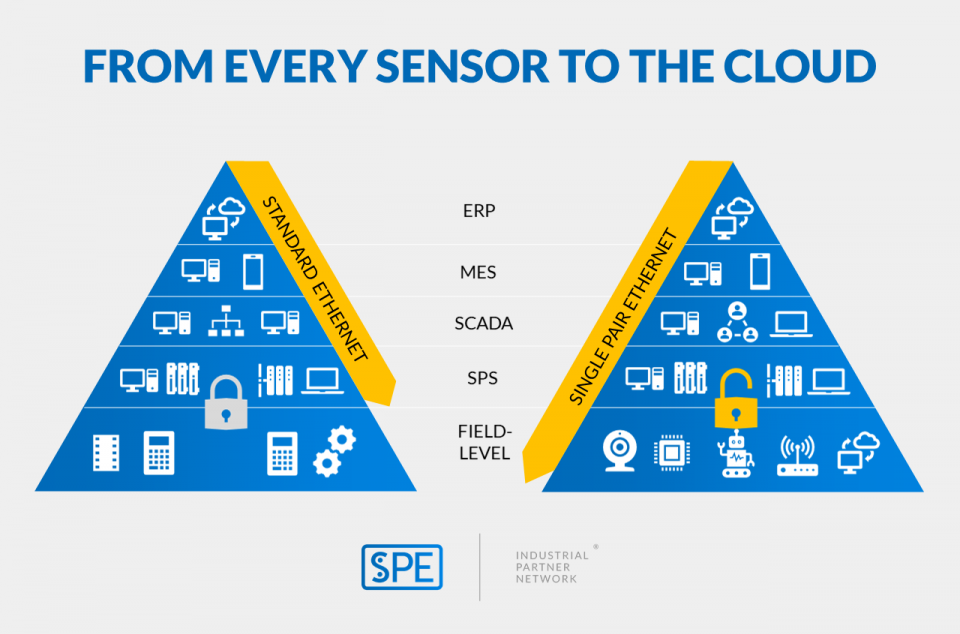
In order to tap the potential of SPE for different applications, a basic understanding of the different possible combinations of protocols, transmission lengths and topologies is helpful.
This article presents possible use cases for Single Pair Ethernet. Case studies illustrate the advantages of SPE with the help of exemplary experimental setups. Those interested in SPE and future users will learn how significantly SPE contributes to the rapid success of the Industrial Internet of Things (IIoT).
INTRODUCTION
SPE is a physical layer networking technology that uses just a single pair of twisted copper wires. SPE enables continuous IP communication between server and cloud as well as a power supply in complex IIoT solutions using Power over Data Line (PoDL). SPE represents the next milestone in network technology and will impact all markets and industries.
Further development of the standards for this technology is paving the way for wide adoption across industries including manufacturing, automation, and commercial retail. This article describes the current landscape of the technology including a broad outline of possible network combinations and applications before diving into concrete SPE application case studies that showcase this exciting technology in use.
THE VALUE OF SPE
SPE allows users to construct efficient network and cabling structures, from sensors, through the control and company level, right through to the cloud, all based on standardized interfaces. It can provide value in both new and existing applications in multiple ways. The benefit of SPE is specific to its application and ranges from simply a significant reduction in cabling weight which leads to other efficiency benefits to the opportunity for completely new IIoT applications that can completely transform manufacturing processes.
It is critical to be reminded that SPE is a multifaceted technology with a huge number of stakeholders and requires innovation at all levels for optimal use. This integrated network of influencers includes the cable and chipset manufacturers as well as OEM’s, and industry advocates.
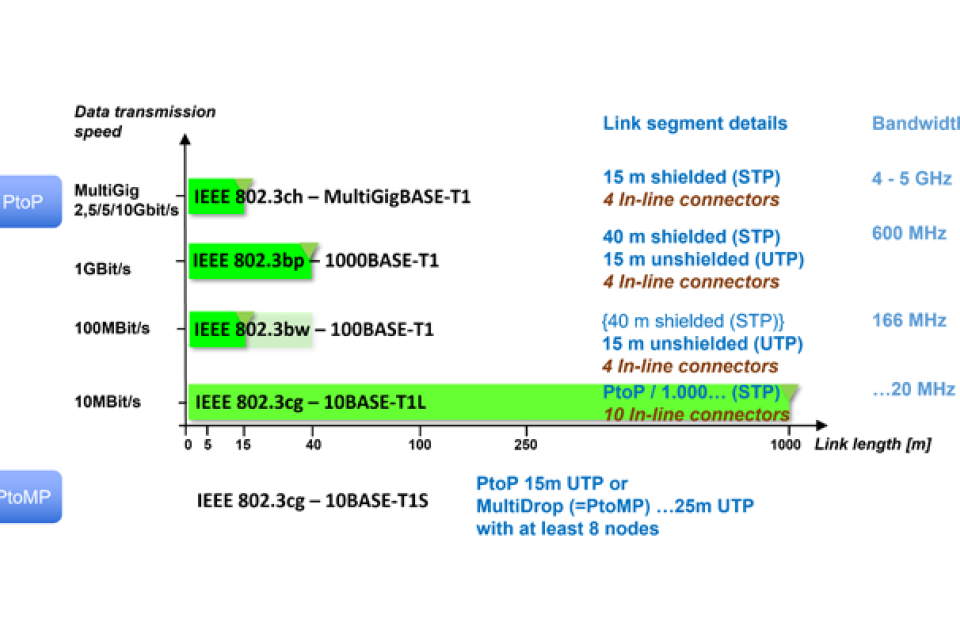
SPE STANDARDS
The IEC standardization committee SC 48B has published the IEC 63171-6 as an international standard for Ethernet interfaces using only single pair wires. The standard describes the “T1 Industrial Style” mating face, standardized mainly by HARTING and TE Connectivity in 2016, as the internationally standardized default interface for SPE networks in industrial M3I3C3E3 environments. The standard specifies SPE interfaces from an IP20 interface up to several IP65/67 versions of M8 and M12 versions.
Other relevant standards include the IEC 61156-x for standardization for SPE cables, ISO/IEC 11801-x series for Standardization cabling systems and the standardized SPE protocol for data and power IEEE 802.3. Each of these standards (Figure 1) which relate to the different aspects of SPE infrastructure play a vital role in the scalability of the technology.
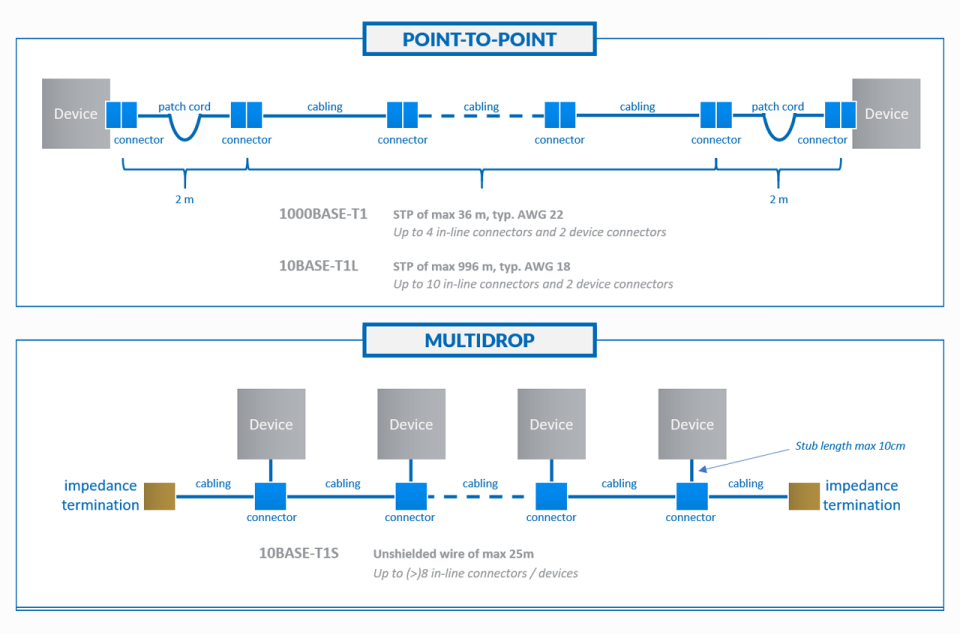
TYPICAL NETWoRK STRUCTURES
For data transmission speed from 10 Mbit/s up to 10 Gbit/s a Point to Point (PtoP) connection is typically used. All these protocols can be combined with the Power over Data Line (PoDL acc. to IEEE802.3bu) for remote powering solutions. IEEE802.3cg also defines 10BASE-T1S as a PHY with two possible ways to work. First, as a Point to Point system with at least a 15 m reach and as a mixing segment with a point to multipoint communication called a MultiDrop (MD) segment. (Figure 2) This is more or less a classical bus system with at least 25 m reach and at least 8 nodes. Unfortunately, 10BASE-T1S does not support PoDL.
A BROAD VIEW OF SPE APPLICATIONS
It is crucial to understand SPE as not a single solution rolled out in the same structure for every application. Instead, it must be thought of as a foundational technology in which several combinations of parts can be arranged together to fit custom solutions. Different SPE protocols with different transmission speeds (Table 1), link lengths, and topologies can be selected for varying applications. An essential consideration is the powering of the device in the field. For all field devices, one cable and connector solution are a must.
SPE protocols, powering systems, network structures
10BASE-T1S
Powering system
M8 / M12 Hybrid with one additional wire pair for power
Network structure
PtoP (15 m) and/or
PtoMP (min. 25 m and 8 nodes)
10BASE-T1L
Powering system
PoDL or Engineered PoDL (APL)
Network structure
PtoP minimum 1.000 m
100 or 1000 BASE-T1
Powering system
PoDL
Network structure
PtoP minimum 40 m
100 or 1000 BASE-T1
Powering system
M8 / M12 Hybrid with one additional wire pair for power
Netzwerkstruktur
Switched line or star structure
Four basic forms of the technology and its applications are as follows:
OPTION 1
with 10BASE-T1S and hybrid powering offers the useful features for sensor/actuator network inside automation applications because of these main features:
- PtoP or PtoMP structure with 10 Mbit/s
- M8 Hybrid cabling system supports daisy chain structures and easy powering of the device without additional parts for PoDL powering.
- With MultiDrop PtoMP a much lower number of ports are needed at the switches to connect a high number of devices.
OPTION 2
will be used for the process industry. Here a long link length is typical and the cable cost will play a significant role. For such applications the PoDL or a modified engineered PoDL powering is perfect.
OPTION 3
For the higher PtoP speed protocols the combination with PoDL powering might a useful option to use the same interface and wire pair to deliver power and data to the devices.
OPTION 4
In combination with specialized sensor manufacturers such as the Perinet GmbH - this option offers the highest flexibility and is a perfect solution for building automation and intelligent edge devices. This is a typical automation application, where all the different speeds and transmission lengths can be used. A typical use case, where we speak about the sensor to cloud abilities of SPE technology.
SPECIFIC USE CASES
The best way to see the potential of SPE is to understand it through specific use cases. The following use cases provide both an overview of the potential of the technology for the industry or application as well as an applied case either in operation now or soon to be launched.
With each case, we aim to provide an overview of why SPE provides the advantage over other possible alternatives as well as offering insights into the application’s challenges and opportunities.
E-Transportation
As cities around the globe focus more and more resources on reducing their carbon footprint and increasing air quality, electronic mass transit options are on the precipice of wide adaptation. SPE is a technology that can go a long way to accelerating innovation in this area by both solving problems that have hindered innovation as well as significantly reducing the costs of current alternatives.
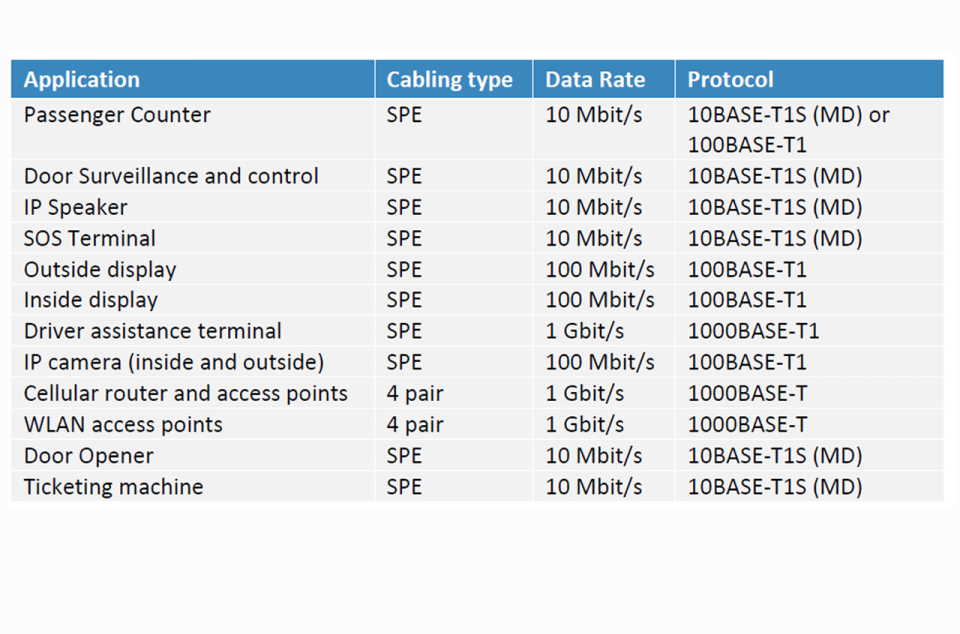
Where SPE shines in e-transport applications (Table 2) is its critical weight reduction from other communication options. SPE offers weight reduction up to 55% and a reduction of the outer diameter, additionally, the bending radius can be reduced by up to 30%. Standard 8-wired cable per 100 meters weighs approximately 4,6 kg compared to single pair cable which weighs approximately 3,0 kg per 100 meters. For battery-operated vehicles, weight directly translates into better battery efficiency and therefore range. SPE can be applied in several areas of an e-transport system including:
Visual and acoustical Passenger Information Systems (PIS)
Here displays both on and off the transport, as well as internal and external speakers and audio systems, use SPE for both power and connectivity.
CCTV
Security measures including cameras, recorders, and CCTV Monitors can use SPE.
Infotainment
The increasingly essential onboard WiFi can be delivered through SPE as well as in In-Seat Audio/Video.
Seat reservation
Seat reservation systems for longer trips can be achieved with SPE. Displays in the seat or over luggage storage areas are easily connected and monitored.
Passenger Counting visual (APC)
Understanding passenger numbers, for capacity monitoring and route optimization, is essential for a modern transport system. Smart sensors in combination with SPE can deliver excellent data for both live monitoring and evaluation.
Automation
SPE has been singled out as an important tool for the ongoing move towards Industry 4.0. Industry 4.0 or the fourth industrial revolution will see manufacturing plants move away from focussing on linear high production models to systems that lean heavily on continuous data gathering and artificial intelligence in a networked environment to present a new form of agile, responsive, and customizable manufacturing. This vision is only achievable through the deliberate adoption of relevant technologies and systems.
A clear example where increased data derived from sensors at the edge is the Perinet GmbH injection molding case study. In this example, a sensor is added to the injection molding process monitoring process. During the injection molding process monitoring, various forms are injected with hot plastic. In each of these forms, there is a small sensor that monitors the pressure of the injecting process for each form. According to this, you can monitor a malfunction within the tool immediately. This is a perfect example of how SPE can be used to connect from the sensor to the cloud.
MONITORING AND REPORTING
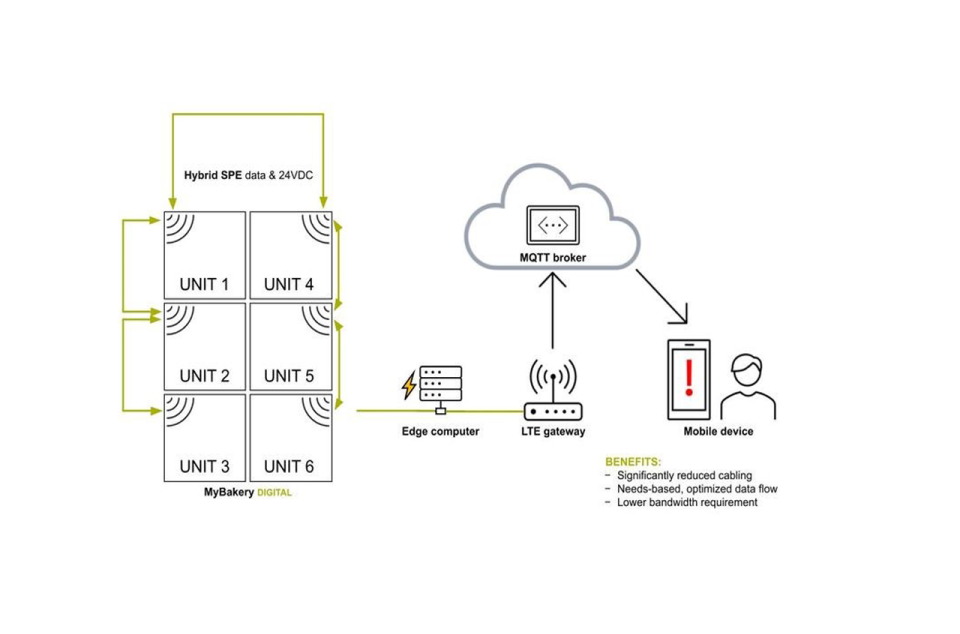
In a commercial setting, a similar setup can be implemented for the smart monitoring of low shelf life goods. The example we will outline here is in a typical fresh bread case. In many European supermarkets, shoppers can choose fresh baked goods from a large cabinet. Often these items have been freshly baked in-store from frozen products. These baked goods have a very short shelf life so optimizing the amount available with timing the cooking process is essential for both delivering a fresh product, meeting demand, and satisfying customer expectations.
An SPE system can use sensors embedded within the bread case itself that monitor fill level of the product on the shelves. This data is then analysed and alerts can be sent to mobile devices if the amount of product goes below a pre-set amount. The system can be devised to not only alert the bakery staff to refill the shelves but also to the baking team which can receive a separate alert when the occupancy rate indicates the shelf will be empty in an expected time frame and they can be prompted to start baking in preparation for the need to refill.
OUTLOOK
Single Pair Ethernet is on a clear path towards being an established technology in manufacturing, automation, and e-transport settings. It is with the continued work of players across the space that will ensure it fulfils its potential.
CONCLUSION
SPE is already proving itself with the featured case studies and its benefits to other industries and applications is clear. The technology will continue to emerge as one of the drivers in the real move towards Industry 4.0 as well as play a significant role in the establishment of sustainable and smart e-transport solutions at all scales.
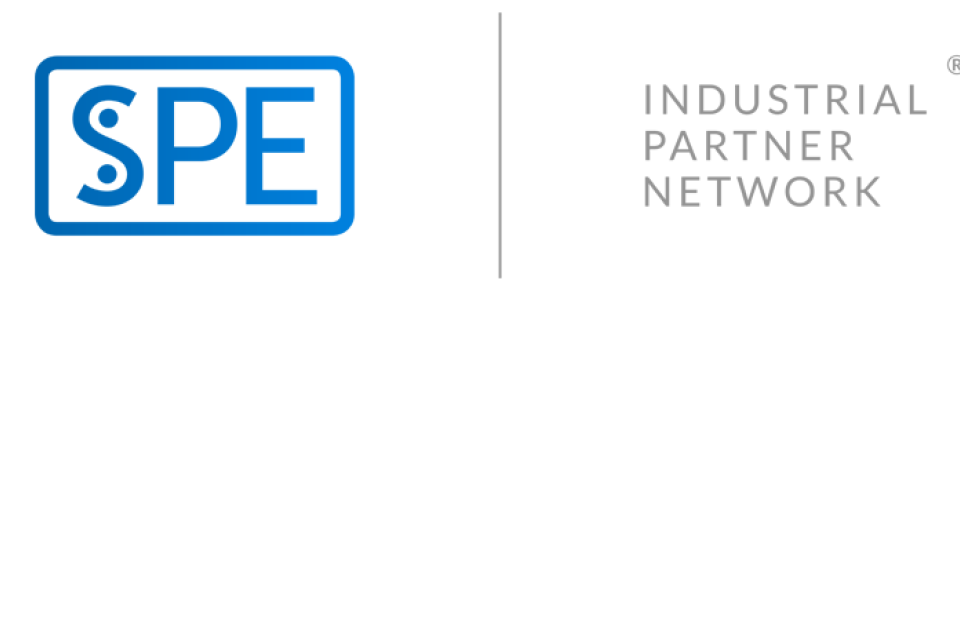
ABOUT THESPE INDUSTRIAL PARTNER NETWORK
The potential of SPE is clear, but the broad rollout of SPE requires work and expertise from a wide range of stakeholders. The SPE Industrial Partner Network was founded by companies with focus in all areas of the SPE ecosystem and advocacy of Single Pair Ethernet. The network works together to ensure that SPE technology is pushed further and faster.
The network provides a reliable platform for all necessary technical experts to cooperate and work together easily over the borders of single companies. Partnerships within the network allow for increases in product and performance variations as well as smoother standardization processes. The founding members of the SPE Industrial Partner Network include HARTING, TE Connectivity, HIROSE, Würth Elektronik, LEONI, Murrelektronik, and Softing IT Networks. Currently, the network has grown up to more than 45 member companies and is increasing weekly.
COPYRIGHT NOTICE
This article was originally published on Wevolver and was created in cooperation with the SPE Industrial Partner Network.
This document is the intellectual property of the SPE Industrial Partner Network e.V., which also holds the exclusive copyright. No part of this document may be modified, reproduced or reprinted without the express permission of the SPE Industrial Partner Network e.V.
The SPE Industrial Partner Network e.V. reserves the right to change this document in whole or in part. All brand and product names are trademarks or registered trademarks of their respective owners.

